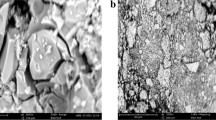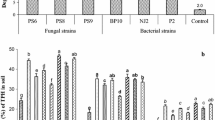Abstract
Based on our previous study in minimal medium, Kocuria rosea and Aspergillus sydowii were identified as the best microbes for degradation of mixture of polyaromatic hydrocarbons (PAHs). The present study reports PAH degradation potential of these microbes in free and immobilized form. PAHs were extracted using QuEChERS-mediated process followed by quantification by high performance liquid chromatography. The microbial consortium of Kocuria rosea + Aspergillus sydowii was formulated in three bio-formulations, namely (i) bentonite-alginate composite beads; (ii) water dispersible granule composite using guar gum-nanobentonite; and (iii) composites of carboxymethyl cellulose-bentonite and were applied in PAH fortified (100 µg g−1) sandy loam soil. Results suggested that degradation data fitted well to first order kinetics as in most of the cases, the values of correlation coefficient (r) were > 0.95. The half-life (t1/2) values for PAHs in the uninoculated control soil were: naphthalene (10.43 d), fluorene (22.43 d), phenanthrene (24.64 d), anthracene (38.47 d), and pyrene (34.34 d). Inoculation of soil with free culture microbial consortium (without or with nutrient) and bio-formulation of degrading cultures enhanced degradation of all PAHs and half-life values were significantly reduced for each PAH: naphthalene (1.76–2.00 d), fluorene (2.52–6.65 d), phenanthrene (4.61–6.37 d), anthracene (9.01–12.22 d), and pyrene (10.98–15.55 d). Among different bio-formulations, guar gum-nanobentonite-based composite exhibited better efficacy for degradation of naphthalene, fluorene, phenanthrene, anthracene, and pyrene. The addition of microbial consortium in PAH fortified soil increased 16S rRNA gene copies of Alphaproteobacteria and Bacteroidetes, compared to the uninoculated, PAH-fortified control. The microbial functional gene assays showed that the gene copies of amoA, nirK, nirS, and anammox increased, suggesting nitrogen regulation in the PAH-fortified soil.





Similar content being viewed by others
Availability of data and materials
The datasets used and/or analyzed during the current study are available from the corresponding author on reasonable request. The data related to accession number of bacteria and fungus were deposited into the National Center for Biotechnology Information (NCBI).
References
Ahmad M, Wang P, Li JL, Wang R, Duan L, Luo X, ... Li WJ (2021) Impacts of bio-stimulants on pyrene degradation, prokaryotic community compositions, and functions. Environ Pollut 289:117863. https://doi.org/10.1016/j.envpol.2021.117863
Bagi A, Knapik K, Baussant T (2022) Abundance and diversity of n-alkane and PAH-degrading bacteria and their functional genes–potential for use in detection of marine oil pollution. Sci Total Environ 810:152238. https://doi.org/10.1016/j.scitotenv.2021.152238
Benedek T, Vajna B, Táncsics A, Márialigeti K, Lányi S, Máthé I (2013) Remarkable impact of PAHs and TPHs on the richness and diversity of bacterial species in surface soils exposed to long-term hydrocarbon pollution. World J Microbiol Biotechnol 29:1989–2002. https://doi.org/10.1007/s11274-013-1362-9
Braker G, Fesefeldt A, Witzel KP (1998) Development of PCR primer systems for amplification of nitrite reductase genes (nirK and nirS) to detect denitrifying bacteria in environmental samples. Appl Environ Microbiol 64:3769–3775. https://doi.org/10.1128/AEM.64.10.3769-3775.1998
Chandran P, Das N (2010) Biosurfactant production and diesel oil degradation by yeast species Trichosporon asahii isolated from petroleum hydrocarbon contaminated soil. Int J Eng Sci Technol 2:6942–6953
Chavez-Gómez B, Quintero R, Esparza-Garcıa F, Mesta-Howard AM, de la Serna FZD, Hernández-Rodrıguez CH, ... & Rodrı́guez-Vázquez R (2003) Removal of phenanthrene from soil by co-cultures of bacteria and fungi pregrown on sugarcane bagasse pith. Bioresour Technol 89:177-183. https://doi.org/10.1016/s0960-8524(03)00037-3
Chen W, Zhang H, Zhang M, Shen X, Zhang X, Wu F, ... & Wang X (2020) Removal of PAHs at high concentrations in a soil washing solution containing TX-100 via simultaneous sorption and biodegradation processes by immobilized degrading bacteria in PVA-SA hydrogel beads. J Hazard Mater 410:124533.https://doi.org/10.1016/j.jhazmat.2020.124533
Chumthong A, Kanjanamaneesathian M, Pengnoo A, Wiwattanapatapee R (2008) Water-soluble granules containing Bacillus megaterium for biological control of rice sheath blight: formulation, bacterial viability and efficacy testing. World J Microbiol Biotechnol 24:2499–2507. https://doi.org/10.1007/s11274-008-9774-7
Day PR (1965) Particle fractionation and particle-size analysis, pp 545–567, ed. C.A. Black, Methods of soil analysis pan I Agronomy Society of America, Madison, Wisconsin.
Deng F, Dou R, Sun J, Li J, Dang Z (2021) Phenanthrene degradation in soil using biochar hybrid modified bio-microcapsules: determining the mechanism of action via comparative metagenomic analysis. Sci Total Environ 775:145798. https://doi.org/10.1016/j.scitotenv.2021.145798
Dou R, Sun J, Lu J, Deng F, Yang C, Lu G, Dang Z (2021) Bacterial communities and functional genes stimulated during phenanthrene degradation in soil by bio-microcapsules. Ecotoxicol Environ Saf 212:111970. https://doi.org/10.1016/j.ecoenv.2021.111970
Fierer N, Jackson JA, Vilgalys R, Jackson RB (2005) Assessment of soil microbial community structure by use of taxon-specific quantitative PCR assays. Appl Environ Microbiol 71:4117–4120. https://doi.org/10.1128/aem.71.7.4117-4120.2005
Gandolfi I, Sicolo M, Franzetti A, Fontanarosa E, Bestetti SA, G, (2010) Influence of compost amendment on microbial community and ecotoxicity of hydrocarbon-contaminated soils. Bioresour Technol 101:568–575. https://doi.org/10.1016/j.biortech.2009.08.095
Jackson ML (1967) Soil Chemical Analysis. Prentice Hall Inc., New Delhi, India
Kachieng’a L, Momba M (2017) Kinetics of petroleum oil biodegradation by a consortium of three protozoan isolates (Aspidisca sp., Trachelophyllum sp. and Peranema sp.). Biotechnol Rep 15:125–131. https://doi.org/10.1016/j.btre.2017.07.001
Khanal A, Lee JH (2020) Functional diversity and abundance of nitrogen cycle-related genes in paddy soil. Appl Biol Chem 63:1–13. https://doi.org/10.1186/s13765-020-00500-6
Khandelwal A, Sugavanam R, Ramakrishnan B, Dutta A, Varghese E, Nain L, Banerjee T, Singh N (2022) Free and immobilized microbial cultures mediated crude oil degradation and microbial diversity changes through taxonomic and functional markers in a sandy loam soil. Front Environ Sci 9:794303. https://doi.org/10.3389/fenvs.2021.794303
Khandelwal A, Nain L, Singh SB, Varghese E, Sharma A, Gupta S, Singh N (2021) Bacteria and fungi mediated degradation of poly aromatic hydrocarbons and effect of surfactant Tween-80. Int J Environ Anal Chem 1-16. https://doi.org/10.1080/03067319.2021.2015584
Kumar A, Nain L, Singh N (2017) Alginate immobilized enrichment culture for atrazine degradation in soil and water system. J Env Sci Health B 52:229–236. https://doi.org/10.1080/03601234.2016.1270680
Li M, Gu JD (2011) Advances in methods for detection of anaerobic ammonium oxidizing (anammox) bacteria. Appl Microbiol Biotechnol 90:1241–1252
Liu XX, Hu X, Cao Y, Pang WJ, Huang JY, Guo P, Huang L (2019) Biodegradation of phenanthrene and heavy metal removal by acid-tolerant Burkholderia fungorum FM-2. Front Microbiol 10:408. https://doi.org/10.3389/fmicb.2019.00408
Mallick S, Chakraborty J, Dutta TK (2011) Role of oxygenases in guiding diverse metabolic pathways in the bacterial degradation of low-molecular- weight polycyclic aromatic hydrocarbons: a review. Crit Rev Microbiol 37:64–90. https://doi.org/10.3109/1040841x.2010.512268
Mohapatra B, Phale PS (2021) Microbial degradation of naphthalene and substituted naphthalenes: metabolic diversity and genomic insight for bioremediation. Front Bioeng Biotechnol 9:144. https://doi.org/10.3389/fbioe.2021.602445
Nunez EV, Valenzuela-Encinas C, Alcántara-Hernández RJ, Navarro-Noya YE, Luna-Guido M, Marsch R, Dendooven L (2012) Modifications of bacterial populations in anthracene contaminated soil. Appl Soil Ecol 61:113–126
Obi L, Atagana H, Adeleke R, Maila M, Bamuza-Pemu E (2020) Potential microbial drivers of biodegradation of polycyclic aromatic hydrocarbons in crude oil sludge using a composting technique. J Chem Technol Biotechnol 95:1569–1579. https://doi.org/10.1002/jctb.6352
Patel AB, Singh S, Patel A, Jain K, Amin S, Madamwar D (2019) Synergistic biodegradation of phenanthrene and fluoranthene by mixed bacterial cultures. Bioresour Technol 284:115–120. https://doi.org/10.1016/j.biortech.2019.03.097
Poly F, Ranjard L, Nazaret S, Gourbière F, Monrozier LJ (2001) Comparison of nifH gene pools in soils and soil microenvironments with contrasting properties. Appl Environ Microbiol 67:2255–2262. https://doi.org/10.1128/AEM.67.5.2255-2262.2001
Rotthauwe JH, Witzel KP, Liesack W (1997) The ammonia monooxygenase structural gene amoA as a functional marker: molecular fine-scale analysis of natural ammonia-oxidizing populations. Appl Environ Microbiol 63:4704–4712. https://doi.org/10.1128/aem.63.12.4704-4712.1997
Rubio LM, Ludden PW (2002) The gene products of the nif regulon. In: Leigh GJ (ed) Nitrogen Fixation at the Millenium. Elsevier, Amsterdam, pp 101–136
Scott NM, Hess M, Bouskill NJ, Mason OU, Jansson JK, Gilbert JA (2014) The microbial nitrogen cycling potential is impacted by polyaromatic hydrocarbon pollution of marine sediments. Front Microbiol 5:108. https://doi.org/10.3389/fmicb.2014.00108
Sharma A, Singh SB, Sharma R, Chaudhary P, Pandey AK, Ansari R, Vasudevan V, Arora A, Singh S, Saha S, Nain L (2016) Enhanced biodegradation of PAHs by microbial consortium with different amendment and their fate in in-situ condition. J Environ Manage 181:728–736. https://doi.org/10.1016/j.jenvman.2016.08.024
Sleight TW, Khanna V, Gilbertson LM, Ng CA (2020) Network analysis for prioritizing biodegradation metabolites of polycyclic aromatic hydrocarbons. Environ Sci Tech 54:10735–10744. https://doi.org/10.1021/acs.est.0c02217
Song L, Niu X, Zhang N, Li T (2021) Effect of biochar-immobilized Sphingomonas sp. PJ2 on bioremediation of PAHs and bacterial community composition in saline soil. Chemosphere 279:130427. https://doi.org/10.1016/j.chemosphere.2021.130427
Su D, Pu Y, Gong C, He Z (2021) Application of cold-adaptive Pseudomonas sp. SDR4 and Mortierella alpina JDR7 co-immobilized on maize cob in remediating PAH-contaminated freeze-thawed soil. Environ Adv 4:100063. https://doi.org/10.1016/j.envadv.2021.100063
Suzuki MT, Taylor LT, DeLong EF (2000) Quantitative analysis of small-subunit rRNA genes in mixed microbial populations via 5′-nuclease assays. Appl Environ Microbiol 66:4605–4614. https://doi.org/10.1128/AEM.66.11.4605-4614.2000
Teng Y, Luo Y, Sun M, Liu Z, Li Z, Christie P (2010) Effect of bioaugmentation by Paracoccus sp. strain HPD-2 on the soil microbial community and removal of polycyclic aromatic hydrocarbons from an aged contaminated soil. Bioresour Technol 101:3437–3443. https://doi.org/10.1016/j.biortech.2009.12.088
Wang T, Su D, He WX, Z, (2020) Adsorption-degradation of polycyclic aromatic hydrocarbons in soil by immobilized mixed bacteria and its effect on microbial communities. J Agric Food Chem 68:14907–14916. https://doi.org/10.1021/acs.jafc.0c04752
Wang D, Qin L, Liu E, Chai G, Su Z, Shan J, ... & Lin Y (2021). Biodegradation performance and diversity of enriched bacterial consortia capable of degrading high-molecular-weight polycyclic aromatic hydrocarbons. Environ Technol 1-31.https://doi.org/10.1080/09593330.2021.1946163
Wen Y, Xu X, Wang B, He Z, Bai J, Chen X, ... & Xu X (2021). PAHs biodegradation in soil washing effluent by native mixed bacteria embedded in polyvinyl alcohol-sodium alginate-nano alumina gel beads. J Environ Manage 297:113415. https://doi.org/10.1016/j.jenvman.2021.113415
Wu Y, Zhu Q, Zeng J, Ding Q, Gong Y, Xing P, Lin X (2016) Effects of pH and polycyclic aromatic hydrocarbon pollution on thaumarchaeotal community in agricultural soils. J Soils Sediments 16:1960–1969. https://doi.org/10.1007/s11368-016-1390-9
Xu Y, Sun GD, Jin JH, Liu Y, Luo M, Zhong ZP, Liu ZP (2014) Successful bioremediation of an aged and heavily contaminated soil using a microbial/plant combination strategy. J Hazard Mater 264:430–438. https://doi.org/10.1016/j.jhazmat.2013.10.071
Xu R, Zhang Z, Wang L, Yin N, Zhan X (2018) Surfactant-enhanced biodegradation of crude oil by mixed bacterial consortium in contaminated soil. Environ Sci Pollut Res 25:14437–14446. https://doi.org/10.1007/s11356-018-1604-3
Yadav S, Sharma A, Khan MA, Sharma R, Celin M, Malik A, Sharma S (2020) Enhancing hexahydro-1, 3, 5-trinitro-1, 3, 5-triazine (RDX) remediation through water-dispersible Microbacterium esteraromaticum granules. J Environ Manag 264:110446. https://doi.org/10.1016/j.jenvman.2020.110446.221
Yi M, Zhang L, Qin C, Lu P, Bai H, Han X, Yuan S (2022) Temporal changes of microbial community structure and nitrogen cycling processes during the aerobic degradation of phenanthrene. Chemosphere 286:131709. https://doi.org/10.1016/j.chemosphere.2021.131709
Zafra G, Taylor TD, Absalón AE, Cortés-Espinosa DV (2016) Comparative metagenomic analysis of PAH degradation in soil by a mixed microbial consortium. J Hazard Mater 318:702–710. https://doi.org/10.1016/j.jhazmat.2016.07.060
Zhao Y, Chen W, Wen D (2020) The effects of crude oil on microbial nitrogen cycling in coastal sediments. Environ Int 139:105724. https://doi.org/10.1016/j.envint.2020.105724
Acknowledgements
Ashish Khandelwal is thankful to Department of Science and Technology and Indian Agricultural Research Institute for providing INSPIRE and IARI Senior fellowship for pursing Ph.D.
Author information
Authors and Affiliations
Contributions
AK: Conduct of experiment, data analysis, and writing. RS: Metagenomics experiment. BR: Design of metagenomics experiment. AD: Biocomposite preparation and assistance. EV: Statistical analysis. TB: QuEChERS method development. LN: Microbe isolation and identification. SBS: Research design. NS: Concept, experiment planning and coordination, and paper correction.
Corresponding author
Ethics declarations
Ethics approval and consent to participate
Not applicable.
Consent for publication
Not applicable.
Competing interests
The authors declare no competing interests.
Additional information
Responsible Editor: Robert Duran
Publisher’s note
Springer Nature remains neutral with regard to jurisdictional claims in published maps and institutional affiliations.
Supplementary Information
Below is the link to the electronic supplementary material.
Rights and permissions
About this article
Cite this article
Khandelwal, A., Sugavanam, R., Ramakrishnan, B. et al. Bio-polysaccharide composites mediated degradation of polyaromatic hydrocarbons in a sandy soil using free and immobilized consortium of Kocuria rosea and Aspergillus sydowii. Environ Sci Pollut Res 29, 80005–80020 (2022). https://doi.org/10.1007/s11356-022-19252-5
Received:
Accepted:
Published:
Issue Date:
DOI: https://doi.org/10.1007/s11356-022-19252-5




